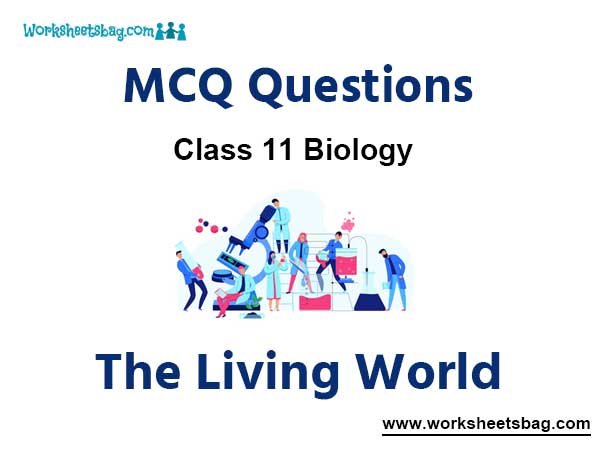Please refer to The Living World MCQ Questions Class 11 Biology below. These MCQ questions for Class 11 Biology with answers have been designed as per the latest NCERT, CBSE books, and syllabus issued for the current academic year. These objective questions for The Living World will help you to prepare for the exams and get more marks.
The Living World MCQ Questions Class 11 Biology
Please see solved MCQ Questions for The Living World in Class 11 Biology. All questions and answers have been prepared by expert faculty of standard 11 based on the latest examination guidelines.
MCQ Questions Class 11 Biology The Living World
Question- Identify the correct sequence of taxonomic categories.
(a) Species → Genus → Order → Class → Family → Phylum/Division → Kingdom
(b) Species → Genus → Family → Class → Phylum → Division → Order → Kingdom
(c) Species → Genus → Family → Order → Class → Phylum/Division → Kingdom
(d) Species → Genus → Family → Order → Class → Phylum/Division → Kingdom
Answer
D
Question- Which of the following is less general in characters as compared to genus?
(a) Species
(b) Division
(c) Class
(d) Family
Answer
A
Question- Match the common name given in column I with their taxonomic category family given in column II and choose the correct combination from the options given below.
Column-I Column-II
(Common Name) (Taxonomic category– Family)
A. Man I. Poaceae
B. Datura II. Anacardiaceae
C. Mango III. Solanaceae
D. Wheat IV. Hominidae
(a) A – IV; B – III; C – II; D – I
(b) A – IV; B – III; C – I; D – II
(c) A – I; B – II; C – III; D – IV
(d) A – I; B – III; C – II; D – IV
Answer
A
Question- The taxonomic unit ‘phylum’ in the classification of animals is equivalent to which hierarchial level in classification of plants ?
(a) Class
(b) Order
(c) Division
(d) Family
Answer
C
Question- Linnaeus system of classification is
(a) Natural
(b) Artificial
(c) Phylogenetic
(d) Progressive
Answer
B
Question- Taxonomic hierarchy refers to
(a) step-wise arrangement of all categories for classification of plants and animals.
(b) a group of senior taxonomists who decide the nomenclature of plants and animals.
(c) a list of botanists or zoologists who have worked on taxonomy of a species or group.
(d) classification of a species based on fossil record.
Answer
A
Question- The system of classification based on evolutionary and genetic relationships among organisms, ignoring the morphological similarities or differences, is called
(a) cladistics
(b) phenetics
(c) classical systematics
(d) new systematics
Answer
A
Question- Which of the following shows the correct example of taxonomic category – Genus?
(a) Potato, tomato and brinjal belong to Solanum.
(b) Monkey, gorilla and gibbon are placed in Mammalia.
(c) Solanum, Petunia, and Datura are placed in Solanacea.
(d) Mangifera indica, Solanum tuberosum, and Panthera leo.
Answer
A
Question- Which of the following is less general in characters as compared to genus?
(a) Species
(b) Division
(c) Class
(d) Family
Answer
A
Question- The common characteristics between tomato and potato will be maximum at the level of their__________.
(a) genus
(b) family
(c) order
(d) division
Answer
B
Question- Which of the following characters given below displays the description of lowest taxonomic category of organisms in the plant and animal kingdom?
(a) It includes one or more than one order.
(b) It is a group containing one or more families.
(c) It is a group of related organisms that resemble one another.
(d) It is a group of organisms that are closely related and share similar characteristics.
Answer
C
Question- Which of the following is the only taxonomic categories that has a real existence?
(a) Phylum
(b) Species
(c) Genus
(d) Kingdom
Answer
B
Question- In angiosperm, characters of flowers are used in classification because
(a) flowers are attractive.
(b) flowers are large.
(c) character of flowers are conserved.
(d) none of the above.
Answer
C
Question- Genus represents
(a) an individual plant or animal.
(b) a collection of plants or animals.
(c) group of closely related species of plants or animals.
(d) none of the above.
Answer
C
Question- Scientific name of Mango plant is Mangifera indica (Linn.) Santapau. In the above name Santapau refers to
(a) Variety of Mango
(b) A taxonomist who proposed the present nomenclature in honour of Linnaeus
(c) A scientist who for the first time described Mango plant
(d) A scientist who changed the name proposed by Linnaeus and proposed present name
Answer
D
Question- Two animals which are the members of the same order must also be the members of the same __________.
(a) class
(b) family
(c) genus
(d) species
Answer
A
Question- Refer the botanical name of wheat “Triticum aestivum”and identify the statement which correctly describes it.
(a) The second word belongs to genus and starts with a small letter.
(b) Both the words “Triticum aestivum” denote the specific epithet.
(c) The first word Triticum denotes the genus which starts with a capital letter.
(d) The first word Triticum denotes the specific epithet while the second word denotes the genus.
Answer
C
Question- The usage of binomial names, for plant species was accepted by all after the publication of the work by
(a) Hooker
(b) Linnaeus
(c) Bentham
(d) Darwin
Answer
B
Question- Family – order – class of Musca domestica (Housefly) are respectively:
(a) Muscidae – Insecta – Hymenoptera
(b) Muscidae – Diptera – Mandibulata
(c) Hymenoptera – Insecta – Mandibuleta
(d) Muscidae – Diptera – Insecta
Answer
D
Question- Determination of age by counting growth rings falls under:
(a) Chorology
(b) Chronology
(c) Dendrology
(d) Dendrochronology
Answer
D
Question-Defining feature of life forms?
(a) Metabolism
(b) Consciousness
(c) Cellular organization
(d) All of the above
Answer
D
Question-In which organism reproduction can be considered as synonymous with growth?
(a) Amoeba
(b) Planaria
(c) Star fish
(d) More then one option are correct
Answer
A
Question- Edaphology is:
(a) Study of soils
(b) Study of amphibians
(c) Study of snakes
(d) Study of elephants
Answer
A
Question-The twin characteristics of growth are:
(a) Increase in number of individuals, increase in mass
(b) Increase in height and increase in mass
(c) Increase in molecular weight and increase in mass
(d) Increase in size and decrease in mass
Answer
A
Question- A living organism is unexceptionally differentiated from nonliving structure on the basis of
(a) Reproduction
(b) Growth and movement
(c) Interaction with environment
(d) Responsiveness
Answer
D
Question- Described biodiversity range?
(a) 1.7 – 1.8 million
(b) 1.1 – 1.8 trillion
(c) 1.7 – 1.8 billion
(d) 17 – 18 billion
Answer
A
Question- The science of giving names to living beings called
(a) Nomenclature
(b) Identification
(c) Classification
(d) Characterization
Answer
A
Question- Select the correctly written botanical/ zoological name
(a) Panthera tigris
(b) Mangifera indica
(c) Sativum pisum
(d) Homo sapiens
Answer
A
Question- Biological names, when hand written, should necessary be:
(a) Underlined
(b) Bold (antics)
(c) In capital letter
(d) Italics
Answer
A
Question- In binomial nomenclature, the first and second components represent:
(a) Genus and species
(b) Genus and class
(c) Species and genus
(d) Kingdom and class
Answer
A
Question- Pesticide used in the Herbarium is:
(a) 2 , 4 – D
(b) NAA
(c) CS2
(d) HgCl2
Answer
A
Question- The main purpose of classification of organisms is to
(a) Study geography
(b) Locate plants and animals
(c) Establish relationships amongst organisms
(d) Study evolution
Answer
C
Question- First book of Botany, Historia Plantarum, was given by:
(a) Theoprastus
(b) A. P. de Condolle
(c) Aristotle
(d) None of these
Answer
A
Question- In Mangifera indica Linn. indica refers to
(a) Genus
(b) Author
(c) Family
(d) Species
Answer
D
Question- Term biology was introduced by:
(a) Aristotle
(b) Darwin
(c) John Ray
(d) Lamarck and Treviranus
Answer
D
Question- In taxonomy the first step is:
(a) Identification
(b) Nomenclature
(c) Classification
(d) Affinities
Answer
A
Question- Improvement of human race through improvement of human environment is:
(a) Anthropology
(b) Euthenics
(c) Euphenics
(d) Eugenics
Answer
B
Question- As we go lower from kingdom to species the number of common characteristics goes on
(a) Increasing
(b) Remain unchanged
(c) Decreasing
(d) Sometimes decreasing
Answer
A
Question- A prediction made by a scientist based on his observation is known as:
(a) Law
(b) Principle
(c) Theory
(d) Hypothesis
Answer
D
Question- Museums are known to preserve:
(a) Insects
(b) Larger animals
(c) Skeleton of animals
(d) All of these
Answer
D
Question- Glucose in taken in test tube and acted upon by hexokinase enzyme. Resulting substrate is glucose – 6 – phosphate. This isolated metabolic reaction is:
(a) Occurring in test tube which can be considered as living
(b)Considered to be in vivo
(c) Considered to be in vitro and living reaction.
(d) Considered as non-living reaction
Answer
C
Question- Basis of Taxonomy are:
(a) Identification – Characterization – Classification – Nomenclature
(b) Characterization – Identification – Classification – Nomenclature
(c) Classification – Characterization – Identification – Nomenclature
(d) Nomenclature – Classification – Identification – characterization
Answer
A
Question- The scientific name of banyan is written as Ficus bengalensis L. which of the following is a correct statement regarding this?
(a) Letter L signifies Latin language.
(b) The name should be reverse with bengalensis preceding Ficus
(c) Letter L signifies taxonomist Linnaeus
(d) Bengalensis is generic name
Answer
C
Question- The disadvantage of using common names for species is that
(a) the names may change.
(b) one name does not apply universally.
(c) one species may have several common names and one common name may be applied to two species.
(d) all of the above
Answer
D
Question- “X” being a higher category is the assemblage of families which exhibit a few “Y” characters. The “Z” characters are less in a number as compared to different genera included in a family. Identify “X”, “Y”, and “Z”.
(a) X – Order; Y – Similar; Z – Similar
(b) X – Genus; Y – Similar; Z – Different
(c) X – Species; Y – Different; Z – Similar
(d) X – Class; Y – Different; Z – Different
Answer
A
Question- Couplet represents the choice made between two opposite options which results in
(a) rejection of both the option.
(b) acceptance of both the option.
(c) either acceptance or rejection of both the option.
(d) acceptance of only one and rejection of the other.
Answer
D
Question- The basic unit of classification is
(a) genus
(b) species
(c) variety
(d) subspecies
Answer
B
Question- Match column-I (Biological name) with column-II (Class) and choose the correct option.
Column-I Column-II
(Biological name) (Class)
A. Homo sapiens I. Dicotyledonae
B. Musca domestica II. Mammalia
C. Mangifera indica III. Monocotyledonae
D. Triticum aestivum IV. Insects
(a) A – IV; B – II; C – I; D – III
(b) A – II; B – IV; C – III; D – I
(c) A – II; B – IV; C – I; D – III
(d) A – II; B – I; C – IV; D – III
Answer
C
Question- Which one of the following is the first step in taxonomy ?
(a) Naming
(b) Description
(c) Identification
(d) Classification
Answer
C
Question- Binomial nomenclature was introduced by
(a) Linnaeus
(b) Darwin
(c) Bentham and Hooker
(d) Aristotle
Answer
A
Question- Read the following statements
(i) Lower the taxon, more are the characteristics that the members within the taxon share.
(ii) Order is the assemblage of genera which exhibit a few similar characters.
(iii) Cat and dog are included in the same family Felidae.
(iv) Binomial Nomenclature was introduced by Carolus Linnaeus. Which of the following statements are NOT correct?
(a) (i), (ii) and (iii)
(b) (ii), (iii) and (iv)
(c) (i) and (iv)
(d) (ii) and (iii)
Answer
D
Question- Which of the following taxonomic category of housefly is incorrectly matched?
(a) Genus – Musca
(b) Family – Muscidae
(c) Order – Primata
(d) Class – Insecta
Answer
C
Question- The most important feature of all living systems is to
(a) utilize oxygen to generate energy.
(b) replicate the genetic information.
(c) produce gametes.
(d) utilize solar energy for metabolic activities.
Answer
B
Question- In the given columns, column I contains the terms and column II contains its description. Select the correct match from the option given below.
Column I Column II
A. Growth I. Production of offspring.
B. Reproduction II. Composed of one or more cells.
C. Metabolism III. Increase in mass and increase in number of individuals.
D. Cellular organization IV. Sum total of all chemical reactions occurring in body.
A B C D
(a) I II III IV
(b) III I II IV
(c) III I IV II
(d) II IV III I
Answer
C
Question-“Ordines Anomali” of Bentham and Hooker includes
(a) seed plants showing abnormal forms of growth and development.
(b) plants represented only in fossil state.
(c) plants described in the literature but which Bentham and Hooker did not see in original.
(d) a few orders which could not be placed satisfactory in the classification.
Answer
D
Question- Two plants can be conclusively said to belong to the same species if they
(a) have same number of chromosomes.
(b) can reproduce freely with each other and form seeds.
(c) have more than 90 per cent similar genes.
(d) look similar and possess identical secondary metabolites
Answer
B
Question- The classification of Linnaeus was mainly based on
(a) Sepals
(b) Carpels
(c) Petals
(d) Stamens
Answer
D
Question- One of the most important functions of botanical gardens is that
(a) they provide a beautiful area for recreation.
(b) one can observe tropical plants there.
(c) they allow ex-situ conservation of germ plasm.
(d) they provide the natural habitat for wildlife.
Answer
C
Question- As we go from species to kingdom in a taxonomic hierarchy, the number of common characteristics
(a) will decrease.
(b) will increase.
(c) remain same.
(d) may increase or decrease.
Answer
A
Question- If an organism is in the same class but not in the same family then it may belong to same
(a) genus
(b) species
(c) variety
(d) order
Answer
D
Question- Match column I with column II and choose the correct option.
Column-I Column-II
A. Family I. tuberosum
B. Kingdom II. Polymoniales
C. Order III. Solanum
D. Species IV. Plantae
E. Genus V. Solanaceae
(a) A –IV; B –III; C –V; D –II; E –I
(b) A –V; B –IV; C –II; D –I; E –III
(c) A –IV; B –V; C –II; D –I; E –III
(d) A –V; B –III; C –II; D –I; E –IV
Answer
B
Question- Which one of the following is correctly matched regarding an Institute and its location? [2004]
(a) National Institute of Virology – Pune
(b) National Institute of Communicable disease- Lucknow
(c) Central Drug Research Institute – Kasauli Institute
(d) National Institute of Nutrition – Mumbai
Answer
A
Question- Match column-I with column-II and choose the correct combination from the options given below.
Column-I Column-II
A. National Botanical I. Carolus Linneaus
Research Institute
B. Indian Botanical II. Taxon
Garden
C. Binomial III. Howrah (India)
Nomenclature
D. A unit of IV. Lucknow
classification
(a) A – III; B – IV; C – I; D – II
(b) A – IV; B – III; C – I; D – II
(c) A – IV; B – III; C – II; D – I
(d) A – IV; B – I; C – III; D – II
Answer
B
Question- Match column I with column II and choose the correct option.
Column-I Column-II
A. Family I. tuberosum
B. Kingdom II. Polymoniales
C. Order III. Solanum
D. Species IV. Plantae
E. Genus V. Solanaceae
(a) A – IV; B – III; C – V; D – II; E – I
(b) A – V; B – IV; C – II; D – I; E – III
(c) A – IV; B – V; C – II; D – I; E – III
(d) A – V; B – III; C – II; D – I; E – IV
Answer
B
Question- Which one of the following animals is correctly matched with its particular named taxonomic category ?
(a) Tiger – Tigris, the species
(b) Cuttle fish – Mollusca, a class
(c) Humans – Primata, the family
(d) Housefly – Musca, an order
Answer
A
Question- Choose the correct one
(i) Growth cannot be taken as a defining property of living organism.
(ii) Dead organism does not grow.
(iii) Reproduction cannot be an all inclusive defining characteristic of living organisms.
(iv) No non-living object is capable of replicating itself.
(v) Metabolism in a test tube is non-living.
(vi) Metabolism is a defining feature of all living organisms.
(a) (i) and (iii)
(b) All except (v)
(c) All except (iii)
(d) All of these
Answer
B
Question- Which of the following organisms is not correctly matched with its particular ?
(a) Human beings – Sapiens, species
(b) Lion – Panthera, genus
(c) Cats – Felidae, genus
(d) Datura – Solanaceae, family
Answer
C
Question- ‘Taxa’ differs from ‘taxon’ due to being
(a) a higher taxonomic category than taxon.
(b) lower taxonomic category than taxon.
(c) the plural of taxon.
(d) the singular of taxon.
Answer
C
Question- Select the correct Match.
Column I Column II
A. Ex-situ conservation I. Central national Herbarium
B. Quick referral system II. Museum
C. Preserved plants and Animals III. Flora
D. Account of habitat
and distribution of
plant in an area. IV. Royal Botanical Garden, Kew.
(a) II III IV I
(b) I IV II III
(c) IV I III IV
(d) IV I II III
Answer
D



